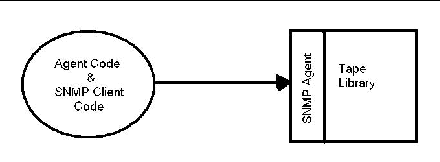| C H A P T E R 1 |
|
Overview |
This chapter provides an overview of the Sun StorageTek Backup Manager (SBM). It contains the following sections:
Sun StorageTek Backup Manager (SBM) provides software that helps you visualize and monitor storage backup environments from a central location. SBM provides valuable information by integrating backup reporting from vendor applications into asset reporting from Sun StorageTek tape libraries.
As the backup administrator, you can increase the reliability of your backup and tape environments by reviewing the data in SBM reports.
SBM is flexible and easy to use, both in smaller environments as well as large scale data centers.
The SBM product is an N-tiered, distributed, scalable architecture. There are four layers in the Sun StorageTek Backup Manager architecture:
FIGURE 1-1 Sun StorageTek Backup Manager Architecture

The data collection layer contains the SBM agents deployed in your backup environment. The agents collect and cache event, configuration, consumption, and performance information from the hardware devices in your storage environment.
There are two types of agents: tape library agents and backup agents.
SBM supports two tape library agents:
The Sun STK library agent collects data from any tape library which has an embedded SNMP agent that supports the L-Series Tape Library MIB version 2.0.
FIGURE 1-2 Sun StorageTek (STK) Library Agent

The agent requires the following configuration information:
The Sun STK library agent communicates with the SNMP agent embedded in the tape library using this configuration information.
The ACSLS agent collects data from an ACSLS tape library through the ACSLS API.
FIGURE 1-3 Sun ACSLS Library Agent

The agent requires the IP Address of the ACSLS server.
| Note - The ACSLS agent cannot be installed on the backup master server or any server running the SSI process. |
The ACSLS agent initiates a SSI session through the ACSLS API. The SSI session creates a communication channel between the agent process and the SSI process. The SSI process communicates with the ACSLS server, which in turn talks to the specific tape library through the CSI interface.
Backup agents collect configuration and transaction (job success or failure) data for each backup job. SBM supports three backup agents:
The backup agents collect the data from the devices using the vendor interfaces (CLI or ODBC). The agent retrieves the data, processes the data into the SBM data structures, and populates the agent cache with the data.
The data aggregation layer enables data collection from the data acquisition agents and passes the data to the data storage layer. There are two key components in this layer:
| Note - These infrastructure agents are controlled by SBM and no user input is required. |
All SBM agents publish a set of table objects that pass data up the layers of the SBM architecture. The agents only need to know where the routing agent is located. All messages are forwarded through the routing agent. The routing agent keeps track of what agents exist in the SBM environment, including the aggregator agent.
When the aggregator agent requests one or more tables, it contacts the routing agent to determine which devices to contact on which ports. The data is then routed through the routing agent back to the aggregator agent and passed up to the SBM database for insertion.
The data storage layer consists of the SBM (PostgreSQL) database and various data collection and management processes running on a single management server. The SBM database serves as the central repository for all persistent data contained within SBM. The primary functions of the database are to:
The database stores three sets of tables: load tables, history tables, and report tables. It contains:
The data presentation layer consists of a web server which serves a web browser with a collection of reports. The SBM web application provides a graphical user interface that makes SBM easy to use.
You are now ready to learn more about the daily operations and common tasks.
Copyright © 2007, Sun Microsystems, Inc. All Rights Reserved.